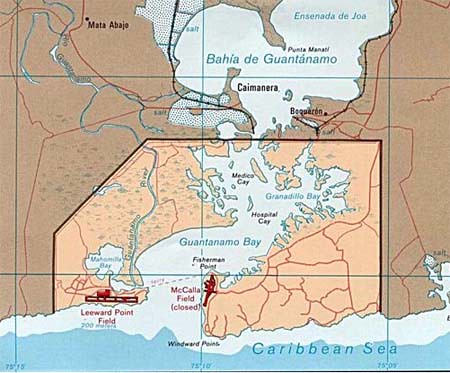Guantánamo and the Border Exodus

[image: A group of Cuban rafters spend the evening playing dominoes in one of the migrant villages at Guantánamo Bay, Cuba. - The Miami Herald, ALBERT DIAZ.]
In a bid to prepare for a possible migrant crisis in Cuba, prompted by the questionable health of Fidel Castro, the U.S. Congress has approved an $18 million proposal for the Department of Defense to build a migrant detention facility on the Navy Base at Guantánamo Bay. Or, excuse me, according to U.S. officials who spoke with The Miami Herald, “to shelter interdicted migrants.”
What does that mean exactly? According to the same article, parts of Guantánamo would be used as a “shelter of last resort if the volume of Cubans interdicted at sea overwhelms the U.S. policy known as wet foot/dry foot." Basically if you paddle your boat and make it to U.S. territory you are safe, otherwise once the Coast Guard nabs you, you are more than likely brought back to Cuba where you are either persecuted by the Cuban government, or held on the naval base until your refugee claim is sorted, or sent to a third country.

[Image: Caribbean migrants preparing for their treacherous voyage to the U.S. Photo by Sarah L. Voisin, for the Washington Post.]
The Herald tells us that “the new installation is needed because terrorism suspects occupy space on the base used in past emergencies to hold large numbers of migrants,” […] facilities “designed to house people from any Caribbean nation who attempt to enter illegally -- not just Cubans.”
But, this begs the question, is the U.S. building out these new facilities to handle a mass Caribbean exodus to Florida in the event of Castro’s death? Or, is that just another excuse to expand the capacity of Guantánamo’s detention space, which, for all intents and purpose, could be used for any number of detainees? “For years, migrants captured during surges ended up in tent camps at Guantánamo on a bluff called Radio Range, on the larger Windward side of the base.”

[Image: Map of Guantánamo Bay showing approximate U.S. Naval Boundaries.]
From 1994 to 1996, more than 40,000 Haitian and Cuban rafters were housed here while politicians debated their refugee status, a history that links the naval base closely to many immigrants in Miami, the Village Voice stated. But now since the U.S. has built its terrorism detention and interrogation center there, the new plan “would put them on the smaller Leeward side, which has an airstrip but no docks for large ships.”
While bids are being solicited, the $18 million “would pay for things like land leveling, sewage and electrical infrastructure, bathrooms, dining facilities and administrative offices to process asylum applications,” and “will be initially designed to handle about 10,000 migrants.”
It’s like Gitmo is becoming an entire city now; a city designed strictly for the purpose of detention. Add this latest expansion to the new terrorist suspect courtroom and processing facility that is going up beside the terrorist detention camp, and you’ve got an even more insidious form of managing immigrants and terrorists simultaneously under the same roof. It’s like Gitmo is quickly becoming some freaky new plug-in architecture, or open-source urban model for securing the border, where the politics of migration and terrorism dangerously and ambiguously overlap.
(This item was spotted at Boing Boing.)







0 Comments:
Post a Comment
<< Home